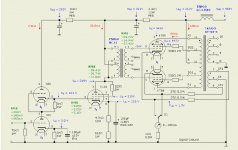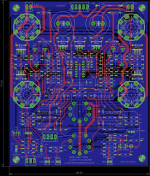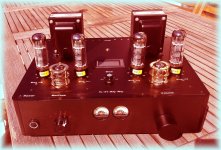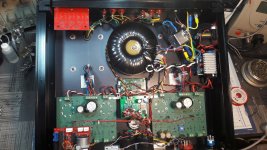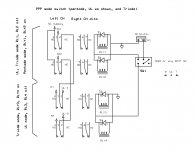Vunce, as long as the capacitor CX1 can stand the AC voltage at the input, the type is not very important. A X2 rated component is still very good to use in this position, even preferable, if it can stand the voltage. Mind that X2 caps are intended for connection across mains input, and therefore are normally rated for max 250 volts AC.
Best regards,
Seppo
Best regards,
Seppo
Hello BandoI83
Actually, I have experience in solid-state DIY but this is first time do the tube power AMP. I have some fool questions about the BH EL34 Rev.2 design. The PCB I received and looked the finishing very well. Following are my questions :
1) Can you tell me the board feedback 1&2 points, what is the function and where of the PCB or OTP transformer make this connection, if i use it ?
2) Does this feedback 1&2 is a mandatory make connection to somewhere ?
3) How the circuit (in middle stage) do the phase splitting or phase inverting ?
4) Where shall I do the connection from PCB output 1-2-3-4-5 to the XE-60-5 ?
I intent to use my old Tango XE-60-5 output at primary 5K impedance, and power tube is KT-66. If I deploy this configuration and wants around 35W per channel, then what kind of parts & voltage need to be modified according to the BH EL34 Rev.2 circuit ? Or any better suggestion from you ?
About the power supply (in mono block), please give me advice :
1) DC supply for filament I know how to make it. Not sure where should I pay more attention ?
2) For the main amplification at high voltage supply portion, if i use the CLC Pi filter, how do I choose the choke and cap values (according to my above requirements) ?
3) How do i choose the power transformer ? How many group of voltage/value /power would be fine ? Transformer I will ask customer make 2 for my mono block.
Thanks for your comments in advance !
Actually, I have experience in solid-state DIY but this is first time do the tube power AMP. I have some fool questions about the BH EL34 Rev.2 design. The PCB I received and looked the finishing very well. Following are my questions :
1) Can you tell me the board feedback 1&2 points, what is the function and where of the PCB or OTP transformer make this connection, if i use it ?
2) Does this feedback 1&2 is a mandatory make connection to somewhere ?
3) How the circuit (in middle stage) do the phase splitting or phase inverting ?
4) Where shall I do the connection from PCB output 1-2-3-4-5 to the XE-60-5 ?
I intent to use my old Tango XE-60-5 output at primary 5K impedance, and power tube is KT-66. If I deploy this configuration and wants around 35W per channel, then what kind of parts & voltage need to be modified according to the BH EL34 Rev.2 circuit ? Or any better suggestion from you ?
About the power supply (in mono block), please give me advice :
1) DC supply for filament I know how to make it. Not sure where should I pay more attention ?
2) For the main amplification at high voltage supply portion, if i use the CLC Pi filter, how do I choose the choke and cap values (according to my above requirements) ?
3) How do i choose the power transformer ? How many group of voltage/value /power would be fine ? Transformer I will ask customer make 2 for my mono block.
Thanks for your comments in advance !
Attachments
Hi ckwong99,
It is funny because you have made solid state amplifiers and you want to try a tube amplifier while I am doing the other way, I have made tube amplifiers and now I am testing a solid state amplifier, only because someone say that the Quasi sound like a tube amplifier Very simple quasi complimentary MOSFET amplifier
I will try to answer your questions :
1) The feedback should be connected to the speaker output of the transformer for a better stability in case of problem, be careful to connect it in the right polarity because it can make an oscillator if unversed, in this case just cross the wire, test at very low volume to avoid a strong sound from the speakers ! Personally I don't use it If you don't use it it can be used for a differential input !
If you don't use it it can be used for a differential input !
2) See point 1, you can leave it open...
3) The phase splitting is made by the ECC83 which is a differential amplifier.
4) I don't have the schema of this transformer but I assume that you should connect P1 (plate), SG1 (screen grid), B+, SG2, P2 to the output connector in this order (see connection info in post 1).
For the Power supply I have already recommended the TOROIDY transformer 250/001 that include all voltages required by the EL34 Baby Huey, see previous post too
You can connect directly the AC voltage to the PCB since there is already diode bridge and a C-R-C filter on board, after you will have tested this easy solution, you can use an external filter, the PCB will accept either DC or AC and the diode bridge will protect you of a wrong connection
If you are using the 330 VAC please use 500 VDC electrolytic capacitors and 630 VDC film capacitors, otherwise 400 VDC capacitors will be OK...
Regards,
Marc
It is funny because you have made solid state amplifiers and you want to try a tube amplifier while I am doing the other way, I have made tube amplifiers and now I am testing a solid state amplifier, only because someone say that the Quasi sound like a tube amplifier Very simple quasi complimentary MOSFET amplifier
I will try to answer your questions :
1) The feedback should be connected to the speaker output of the transformer for a better stability in case of problem, be careful to connect it in the right polarity because it can make an oscillator if unversed, in this case just cross the wire, test at very low volume to avoid a strong sound from the speakers ! Personally I don't use it
2) See point 1, you can leave it open...
3) The phase splitting is made by the ECC83 which is a differential amplifier.
4) I don't have the schema of this transformer but I assume that you should connect P1 (plate), SG1 (screen grid), B+, SG2, P2 to the output connector in this order (see connection info in post 1).
For the Power supply I have already recommended the TOROIDY transformer 250/001 that include all voltages required by the EL34 Baby Huey, see previous post too

You can connect directly the AC voltage to the PCB since there is already diode bridge and a C-R-C filter on board, after you will have tested this easy solution, you can use an external filter, the PCB will accept either DC or AC and the diode bridge will protect you of a wrong connection
If you are using the 330 VAC please use 500 VDC electrolytic capacitors and 630 VDC film capacitors, otherwise 400 VDC capacitors will be OK...
Regards,

Marc
Hi mbates14,
To drive the EL34 output Push-Pull, the ECC83 is not powerful enough and you need a driver stage. In the past it was common to use a tube as a cathode follower but this have several inconveniences, by example since the cathode will be at about 150 V the voltage between the heater and the cathode will exceed the 100 V normally specified for tubes, therefor in most amplifier using this solution the designer carefully bias the heater at 75 V to have a compromise between input tubes with the cathode close to 0 V and the driver at 150 V
Beside that the cathode follower has no amplification function, and a MOSFET is doing this job very well without degradation of the quality of the tube amplifier Therefor it is nice to use modern technology, that was not available in the past, where it can help to build better tube amplifier today
Therefor it is nice to use modern technology, that was not available in the past, where it can help to build better tube amplifier today 
Rgds,
Marc
To drive the EL34 output Push-Pull, the ECC83 is not powerful enough and you need a driver stage. In the past it was common to use a tube as a cathode follower but this have several inconveniences, by example since the cathode will be at about 150 V the voltage between the heater and the cathode will exceed the 100 V normally specified for tubes, therefor in most amplifier using this solution the designer carefully bias the heater at 75 V to have a compromise between input tubes with the cathode close to 0 V and the driver at 150 V
Beside that the cathode follower has no amplification function, and a MOSFET is doing this job very well without degradation of the quality of the tube amplifier
Rgds,

Marc
Understand that, but if the ECC83 isnt powerful enough, then how did they do it in the past?
I have seen 12AT7, 12AU7 and a bunch of other tubes as phase splitters/drivers.
This reminds me of my lost love, Scott 250 monoblocks, 50 watts with 2x 12AX7.
This reminds me of my lost love, Scott 250 monoblocks, 50 watts with 2x 12AX7.
Aaahhhhh yes those. Man its been awhile since I have heard HH Scott 250s.
Hi BandoI83,
Thanks for your reply. If i use my Tango XE-60-5 output at primary 5K impedance, and use power tube KT-66. Whether which parts, value and B+ voltage need to be changed ? Or any power tube you can suggest ?
1) Attached is the XE-60-5 applied connection on another design for your reference.
2) About the the PCB Feedback-1 & 2 , do you mean I can connect it corresponding to speaker output terminals "4,8,16 ohm" & "0 ohm" ?
Thanks for your reply. If i use my Tango XE-60-5 output at primary 5K impedance, and use power tube KT-66. Whether which parts, value and B+ voltage need to be changed ? Or any power tube you can suggest ?
1) Attached is the XE-60-5 applied connection on another design for your reference.
2) About the the PCB Feedback-1 & 2 , do you mean I can connect it corresponding to speaker output terminals "4,8,16 ohm" & "0 ohm" ?
Attachments
Hi ckwong99,
OK, it's what I was thinking, you can connect your Tango output transformer like it is indicated in my previous post, the cathode feedback wiring is not used in the EL34 Baby Huey, I will be using this feature in a new project, the TENA / Baby Huey Quad KT120 (see preliminary schema and PCB)... The Tango is a very nice output transformer
The feedback input can be connected to the 8 or 16 ohms and GND outputs but you will have to change the feedback resistor R1 to adapt it to the level of the output signal and the level of feedback you want. Again most people don't like global feedback and if your amplifier is stable you can use it without feedback !
For power tube I have listed a comparison of several popular ones that can be used with the EL34 Baby Huey PCB, see attached.
Marc
OK, it's what I was thinking, you can connect your Tango output transformer like it is indicated in my previous post, the cathode feedback wiring is not used in the EL34 Baby Huey, I will be using this feature in a new project, the TENA / Baby Huey Quad KT120 (see preliminary schema and PCB)... The Tango is a very nice output transformer
The feedback input can be connected to the 8 or 16 ohms and GND outputs but you will have to change the feedback resistor R1 to adapt it to the level of the output signal and the level of feedback you want. Again most people don't like global feedback and if your amplifier is stable you can use it without feedback !
For power tube I have listed a comparison of several popular ones that can be used with the EL34 Baby Huey PCB, see attached.
Marc
Attachments
OK, it's what I was thinking, you can connect your Tango output transformer like it is indicated in my previous post, the cathode feedback wiring is not used in the EL34 Baby Huey, I will be using this feature in a new project, the TENA / Baby Huey Quad KT120 (see preliminary schema and PCB)... The Tango is a very nice output transformer
Very nice board, Marc. I am interested in this version, will follow this.
Hi,
The op amp is used for the auto-bias because with a stereo quad you will have to adjust 8 trimmers for setting the bias on the 8 output tubes With the auto-bias, you will adjust only one tube per channel and the 3 others will be automatically adjusted too
With the auto-bias, you will adjust only one tube per channel and the 3 others will be automatically adjusted too 
This design is inspired by the very nice TENA amplifier from Norman Koren : The Emperor's New Amplifier and the Baby Huey of gingertube for the shunt feedback and the MOSFET drivers to save 4 tubes ! I don't know yet if it will work since I have not enough knowledge to test it with LTSpice...
I will start a separate thread when I will be ready to work fully on this project, now I want to support the EL34 Baby Huey first and finish my own which will be ready soon now, see pictures... I hope to see also the picture from the others builders, nearly 400 boards have been sold, therefor there could be close to 200 stereo amplifiers...
After this GB will be finish and many will have built the EL34 Baby Huey, I will spend all my time on the quad and I hope that there will be a lot of enthusiasm for the new one too
Best regards,
Marc
The op amp is used for the auto-bias because with a stereo quad you will have to adjust 8 trimmers for setting the bias on the 8 output tubes
This design is inspired by the very nice TENA amplifier from Norman Koren : The Emperor's New Amplifier and the Baby Huey of gingertube for the shunt feedback and the MOSFET drivers to save 4 tubes ! I don't know yet if it will work since I have not enough knowledge to test it with LTSpice...
I will start a separate thread when I will be ready to work fully on this project, now I want to support the EL34 Baby Huey first and finish my own which will be ready soon now, see pictures... I hope to see also the picture from the others builders, nearly 400 boards have been sold, therefor there could be close to 200 stereo amplifiers...
After this GB will be finish and many will have built the EL34 Baby Huey, I will spend all my time on the quad and I hope that there will be a lot of enthusiasm for the new one too

Best regards,
Marc
Attachments
Hi,
The op amp is used for the auto-bias because with a stereo quad you will have to adjust 8 trimmers for setting the bias on the 8 output tubesWith the auto-bias, you will adjust only one tube per channel and the 3 others will be automatically adjusted too

This design is inspired by the very nice TENA amplifier from Norman Koren : The Emperor's New Amplifier and the Baby Huey of gingertube for the shunt feedback and the MOSFET drivers to save 4 tubes ! I don't know yet if it will work since I have not enough knowledge to test it with LTSpice...
I will start a separate thread when I will be ready to work fully on this project, now I want to support the EL34 Baby Huey first and finish my own which will be ready soon now, see pictures... I hope to see also the picture from the others builders, nearly 400 boards have been sold, therefor there could be close to 200 stereo amplifiers...
After this GB will be finish and many will have built the EL34 Baby Huey, I will spend all my time on the quad and I hope that there will be a lot of enthusiasm for the new one too
Best regards,
Marc
Looks great Marc.
Hi ckwong99,
OK, it's what I was thinking, you can connect your Tango output transformer like it is indicated in my previous post, the cathode feedback wiring is not used in the EL34 Baby Huey, I will be using this feature in a new project, the TENA / Baby Huey Quad KT120 (see preliminary schema and PCB)... The Tango is a very nice output transformer
The feedback input can be connected to the 8 or 16 ohms and GND outputs but you will have to change the feedback resistor R1 to adapt it to the level of the output signal and the level of feedback you want. Again most people don't like global feedback and if your amplifier is stable you can use it without feedback !
For power tube I have listed a comparison of several popular ones that can be used with the EL34 Baby Huey PCB, see attached.
Marc
very good layout, I like it much
Can CFB and SchadeFB work together successfully?
I read that more or less are the same thing.
UL40-S2-Mod
Last edited:
- Home
- Amplifiers
- Tubes / Valves
- EL34 Baby Huey Amplifier
